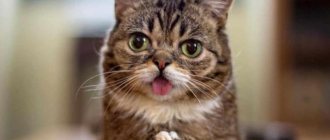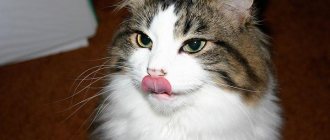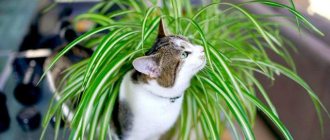Cats are independent and wild animals, but they remain favorites among most people. Owners of these pets know how gentle these animals can be. Sometimes cats even lick the palms of their owners with their rough tongue.
A natural question arises: why does the tongue of their pets have roughness, unlike dogs, and what function does it perform?
Rough tongue
We all feel that same roughness when a cat licks our hands. This is explained by the fact that cats have a large number of papillae on their tongue. There are 4 types of them:
- Filiform (cone-shaped) - these are the papillae that are responsible for the brush effect. This is because they grow in the opposite direction to the sky. This helps the animal take care of its fur. In addition, your pet has the largest number of them, since this form of papillae is the most common. They occupy the anterior half of the tongue.
- Leaf-shaped are the largest papillae, which are located on both sides of the tongue.
- Mushroom - as the name suggests, they are shaped like mushrooms. They are located at the edges of the cat's tongue.
- Grooved - these papillae are located on the back of the tongue. By their arrangement they form a V-row. In front of them are the fungiform papillae.
Why do cats stick out their tongues?
Many people have noticed more than once that after a cat licks its fur, a piece of its tongue remains stuck out. In this case, there is no need to worry - the pet simply forgot to put it back. This happens quite often in cats with short jaws, such as Persians and Exotic Shorthairs. This happens due to a discrepancy between the length of the jaw and tongue. It looks very cute, and it seems as if your favorite pet is sticking its tongue out at you.
However, if your pet is constantly sticking out his tongue and you observe any other symptoms, then consult a veterinarian.
When caring for a pet, it is very important to monitor deviations in the cat’s behavior, because this can indicate various diseases of the animal.
Functions
The functions of a cat's tongue are quite obvious. With its help, the animal takes care of itself by licking its fur. It also removes food debris from the mouth and face. We have all seen how a cat washes itself: after wetting its paw, it runs it over its face. These manipulations help cleanse it.
In addition, with the help of its tongue, the cat tastes the food offered to it and determines its temperature. If these criteria do not suit her, she will not eat the food you give her.
The peculiarity of the structure of the papillae of a cat's tongue provides it with the ability to drink water and liquid food. Running its tongue along the surface of the water, the cat lifts it, creating a trickle, which it drinks.
How to make grooming easier for your cat?
We use a hair comb and take care of this personal care product regularly. A similar approach is needed for cat tongue. Hair can get tangled between the hard papillae, which must be removed, otherwise it can cause serious harm to the health of your pet.
Much of the hair that a cat ingests comes out in feces or vomit. If stray hairballs remain in the gastrointestinal tract, the use of laxatives or even surgery cannot be avoided.
To prevent the animal from swallowing fur, it needs help in grooming itself. To do this, it is enough to regularly comb the cat’s body with a brush, removing dead hairs. Then it will be easier for felines to groom themselves without harm to their health.
Not all cats use such positive characteristics of their tongue. Lazy and overweight individuals prefer to be groomed by their owners, so they do not groom themselves. It is known that cats are more careful than cats; the latter are much less likely to use their rough tongue as a comb.
Swallowing objects
The reason why cats have a rough tongue is their tendency to swallow various inedible objects. Everyone noticed the animal’s love for Christmas tree tinsel, laces and other hanging objects.
This all happens because, due to the structure of the tongue, a cat, having taken an object into its mouth, can no longer get rid of it. And the only option they have is to swallow the object. The papillae of the tongue simply push the object deep into the digestive tract.
This situation is not always harmless. For example, cats love to swallow needles. The animal is interested in the thread on the needle. During the game it turns out that it is not separated from the tongue. It becomes simply impossible to remove the thread. Due to the direction of the papillae and swallowing movements, the thread gradually moves deeper into the pharynx, carrying the needle with it. And finally the cat can only swallow them. The needle penetrates the digestive tract. In most cases, everything works out well, because the needle is swallowed with the blunt end and also goes all the way through. However, this does not always happen; there are also cases of injury.
Language structure
The organ has several types of protrusions directed into the animal's throat.
The feline organ consists of many muscle fibers that allow vertical, horizontal movements, extension and downward bending. On top is the mucous membrane. Under a microscope, hardened protrusions are visible across the entire surface of the tongue, which are inclined towards the pharynx. Numerous capillaries are visible through the outer shell, covered with a protective substance keratin. The muscle also contains short, thin projections on which receptors are located for detecting the three basic tastes - bitterness, sourness and saltiness. Whether a pet can distinguish sweetness is unknown, because the processes responsible for recognizing this flavor have not been found in cats.
Feel
Why do cats have rough tongues? Because it is dotted with papillae. But this not only gives the animal additional positive characteristics. It also increases the sensitivity of the tongue. If a cat injures its tongue for any reason, then this pain will exceed the sensations that the cat would experience if another part of the body was injured. The tongue turns out to be much more sensitive than the paw, tail or ear.
By the way, due to the fact that the cat has a rough tongue, its teeth always remain clean and sharp.
It’s also no secret that the tongue is a storehouse of taste buds. The receptors on the cat's tongue are also responsible for distinguishing taste, but in a slightly different way. Firstly, a cat has much fewer receptors themselves. If a person has about 9000 of them, then an animal has only 473. Secondly, despite the smaller number, they distinguish tastes more sharply and strongly.
In addition, due to the peculiarities of the tongue, cats provide themselves with the function of thermoregulation. You've probably often noticed that during hot weather, your pet sticks its unit out. She does this to evaporate excess moisture from the body, since the cat does not have sweat glands that provide this. This way the pet lowers its body temperature.
Cat's sense of taste
Cats' sense of smell is much more developed than that of humans, but there are an order of magnitude fewer taste buds. Humans have 9,000 of them, while cats have only 473. Taste buds are located on the grooved, leaf-shaped and mushroom-shaped papillae of the tongue. Unfortunately, they are not available on thread-like ones.
Scientists still don't know if cats taste sweetness. Some are convinced that it is not, while others say that it is. Be that as it may, many pets enjoy eating ice cream or delicious cookies. Although it is strictly forbidden to give such products to them.
Cats have a very sensitive tongue and prefer to eat food that is at a temperature of 30 degrees. This is why many cats do not eat food from the refrigerator. If possible, remove cat food from the refrigerator in advance to allow it to cool to room temperature.
Why do cats have rough tongues?
In general, all representatives of the cat family, from our beloved domestic babies to graceful tigers, have rough tongues.
The thing is that the capillary papillae on the surface of the cat's tongue have a special pointed shape and, in addition, are covered with keratin, which is what hair and nails are made of.
That is, if you look at a cat’s tongue up close, it’s a surface covered with a bunch of small spines, a so-so sight, it’s better not to look closely :) In fact, such an amazing structure of the tongue is a real gift from nature, because it has several functions at once.
Main functions
So, why is a cat's tongue rough? In the wild, it was the keratinized spines that appeared on their tongues as a result of evolution that made it easier for predator cats to eat.
The language for cats is a kind of:
- "fork"
- "spoon"
- "knife"
- "comb"
- "shower"
- "air conditioner"
- health test substitute
The keratinized projections on the cat's tongue ensure that it performs various functions:
- make it easier for cats to perform their specific ritual of washing - licking fur (grooming);
- ensure food intake and make it easier to eat meat and fish located in hard-to-reach places;
- help scoop and hold liquid before swallowing;
- signal a change in the cat's health:
- a black tongue is evidence of vitamin deficiency;
- the white color of the tongue indicates problems with the functioning of her digestive system;
- pale brown and gray color indicate problems with the respiratory system;
- yellow coating on a cat’s tongue is a signal of problems with the liver or kidneys;
- an unnaturally pale tongue is evidence of a malfunction in the animal’s cardiovascular system.
What a pleasure to drink when you are thirsty!
Care tool
Cats are famous tidy people. Scientists have calculated that one cat spends approximately 2.5 hours per day using its rough tongue as a “brush with soap.”
I, unlike some, don’t stick my tongue out for no particular reason.
Source of taste impressions
The cat's tongue is the most important organ of taste for these rather picky eating animals. With their rough tongue, which has super-sensitive receptors, cats determine the texture of food and whether it is too hot for them.
Natural "refrigerator"
The cat's tongue also has the ability to regulate body temperature. Representatives of the Technological University (Georgia, USA), concerned with the study of the mechanism of “work” of the cat’s tongue, came to the following results (according to the journal Science).
Ensuring hygiene for yourself and your offspring is not the only property of a rough cat’s tongue. In hot weather conditions, the specific structure of the cats' tongue comes to the rescue. During the process of licking, the liquid contained in the specific papillae of their tongue significantly lowers their body temperature.
Using computed tomography, American researchers found that the specific papillae present on the tongues of cats have different sizes. Those located in the center of the tongue are smaller in size than the papillae located on the sides. It is the lateral papillae of the tongue that play a greater role in licking. These scientists also established the fact that as a result of licking, a cat’s body cools by about 25%, making it difficult for them to overheat.
In extreme heat or when there is excessive stress, the animal breathes often, sticking out its tongue, this also helps to cool the body.
Licking each other as an indicator of empathy
Empathy, as empathy for the current psycho-emotional state of another, is inherent in cats to a sufficient extent: by licking another cat/another animal, a cat shows its emotional attachment and care.
I'm always happy to help, it's not for nothing that I was given such a tongue
It is quite rare for a cat to lick a person's face. However, if this happens, a person should not be “rude” to the cat or push it away, as this may harm its feelings. After all, by doing this, she clearly demonstrates to you that she cares. The serious sensory and emotional potential that cats have, they can (should not!) reveal in relation to those people with whom they live. Felinologists have found that cats' feelings and emotions are quite comparable to the feelings and emotions of people. The ability to empathize is one of the answers to the question: why does a cat have a rough tongue? In order to indicate to a person your feelings, to draw attention to yourself, because it is hardly possible not to notice his specific touch.
We are also capable of showing empathy, sympathy and antipathy.
Why does a cat have a rough tongue?
To have a great hairstyle
Have you noticed that even street cats, provided they are not sick, have excellent hairstyle? What's the secret? The fact is that the tongue replaces two salon procedures for a cat at once: washing and combing. Fluffies don’t just lick their fur; thanks to the spikes on their tongues, they can untangle the fur, preventing the formation of tangles.
But such a tool helps the cat maintain beauty and cleanliness in any conditions.
Fact #5: Spikes can cause hairballs in your cat.
Grooming is an integral part of a cat's normal day. However, due to the fact that the “spikes” on the tongue are directed towards the throat, in a calm state after grooming, part of the fur may remain in the oral cavity and travel further along the gastrointestinal tract.
This is why it is important to comb your cat during shedding, and also to avoid the formation of lumps, protect the body and safely remove them, you need to choose special lines of food for removing hair from the body.
For example, Cat Chow® brand diet for hairball control. The food is created on the basis of high-quality protein and natural ingredients. It is specially formulated with a high fiber content, which helps remove hair from the stomach. Particularly suitable for cats living indoors. You can learn more about Cat Chow® brand food and choose yours here.
Are there any disadvantages to such a device?
As it turns out, there is a catch everywhere. It is because of the rough tongue that cats cannot spit out the fur, which sticks to the tongue during licking. The fur accumulates in the stomach, forming into lumps that have to be burped, which is unpleasant for both the cat and the owner.
Advice:
Since our youngest cat is very, very fluffy, the problem of lumps in the stomach is relevant for us. I periodically give both cats (since they have a habit of licking each other) paste or treat pads to remove fur.
Source










